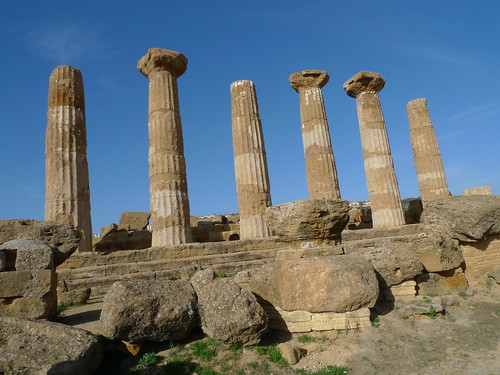
Image : http://www.flickr.com
Charles Lewis Tiffany, founder of Tiffany & Co. in 1837, succeeded in providing the elite with classic silver jewelry. A recognized blue box and white ribbon has been the staple for Tiffany & Co., enticing buyers since the beginning, such as Queen Victoria of England, and to this day keeps with Tiffany's vision of timeless, elegant pieces.
Tiffany's son, Louis Comfort Tiffany didn't live in his father's shadow; in fact, he thrived in the artistic realm, with studies in glass and mosaics. He was born on February 18, 1848 in New York City, and strayed from the family business.
Tiffany began his studies under American landscape artist George Inness in 1866 at the age of 18 absorbing composition, color and technique. During his 20's, he had the opportunity to travel Europe, the Middle East and North Africa. Fortunately, due to his family's wealth, he was able to visit Europe more than once between 1865 and 1872. It was during these travels, that Tiffany developed a love and interest in Islamic architecture, Romanesque and Moorish art and Japanese ceramics.
His studies in glass and mosaics began in 1872 at the age of 24. Upon returning to the United States, he dived into experiments with iridescent glass by exposing hot glass to a series of fumes and metallic oxides. These experiments were conducted with painter John La Farge; Tiffany and La Farge studied glassmaking at the Heidt glassworks in Brooklyn.
In 1879, Tiffany founded the Louis C. Tiffany Company, Associated Arts which decorated private and public buildings. Fascinated by ancient Greek and Roman glass that had been buried for years, Tiffany's pursuit to duplicate an iridescent finish became his obsession, and by 1880, he applied for patents on this type of finish.
Tiffany's design of stained glass windows became ever popular, and he came up with an innovative idea to use the bits of glass left over to create stunning Tiffany lamps. During a job lighting the first movie theater, Tiffany worked with Thomas Edison. Surging together with Edison, the two designed electric lamps. This great collaboration of minds influenced Tiffany to continue creating lamps, and his mini stain glass designs were known world-wide. Tiffany Lamps were either designed by Tiffany himself or by artists that were strictly under his supervision, and with superb craftsmanship.
During the 1930's and 1940's the popularity of Tiffany Style Lamps succumbed to the popular Art Moderne and Expressionism styles. Tiffany Lamps were thought too ornate for the emerging décor, and it wasn't until the 1950's that the "light came back on." Collectors and museums popularized the mosaic beauties once again, and in 1998 two lamps sold at nearly 2 million dollars apiece.
Innovative, with a true love of his craft, Louis C. Tiffany's lighting concepts are still admired today and an original Tiffany lamp remains a valuable commodity. With his passion for color, nature and lighting, Tiffany turned on the light for the world, showing us beauty, through breath-taking chips of glass.
Rob Mabry is a former military journalist living in San Antonio. He writes about travel, technology and history. Rob operates Tiffany Lamp Style along with his wife Sherry.